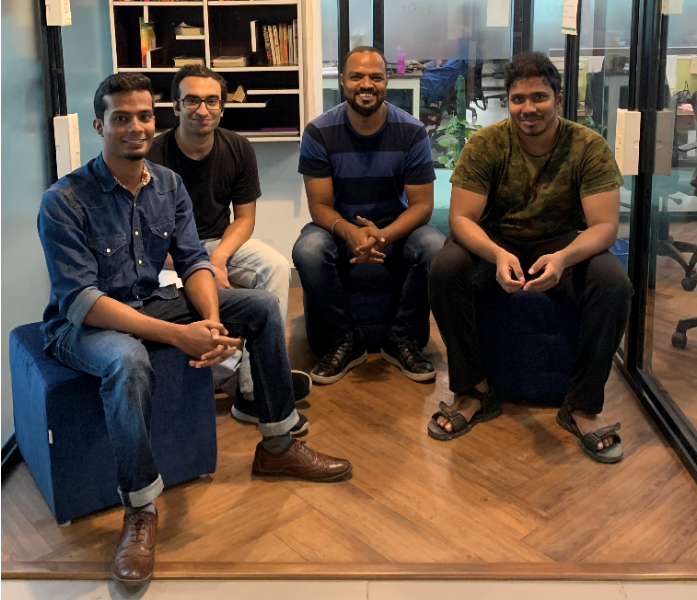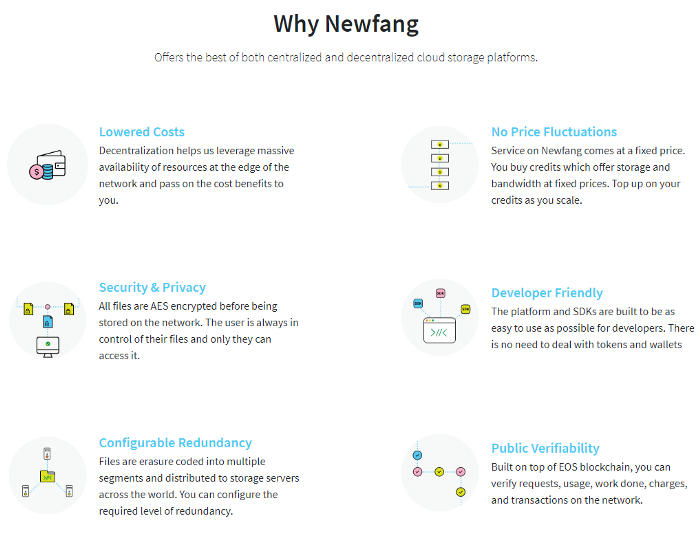Intro: Today we meet up with the Newfang team to delve into what Newfang can offer to the EOS Community and beyond. We have with us Mayur, Co-founder and CEO, and Aravindh, Co-founder, of Newfang. Newfang is a decentralized cloud storage platform for DApps which is a great alternative to IPFS and AWS S3. They have just launched an Alpha and are offering free storage and bandwidth to developers. You can signup at www.newfang.io or email hello@newfang.io
Q 1: Hello Aravindh & Mayur, thank you both for joining us today. Newfang is a project that’s opening up it’s doors to the EOS Community. Why build on EOS?
Mayur: EOS is the only public chain on mainnet that consistently offers very high throughput which is very important for our use-case. Additionally, EOS user auth features allow for a very nice abstraction, allowing our users to log transactions to the blockchain without needing their interference.
Q 2: Newfang isn’t the teams first project. What projects has the team worked on previously?
Aravindh: Before starting Newfang, the team, Mayur, Myself, and another founding member Abhishek, had previously worked together for the past four years for a product development firm. As a result, we built a lot of products, ranging from SaaS, Social Media, EdTech, Travel, E-commerce to Enterprise.
Mayur: If we are being specific to blockchain, we had built over 5+ products in Blood donation, Supply chain, VPN, Lending, & Cross-border payments on various platforms such as EOS, Ethereum & Hyper Ledger

Q That’s great to hear! Your team sounds like they’re exposed to a lot of today’s high profile code bases and chains. Is this the biggest project to date?
Mayur: We want to do to storage what Bitcoin is doing to money, so in terms of potential, yes, this is the biggest challenge we’ve taken on to date. Honestly, if it weren’t that big, we probably wouldn’t have bothered.
Q 3: Cloud storage is today’s new expected area of data storage. Can you give an example of how a business would benefit from storing data by using Newfang?
Aravindh:
Decentralized applications need decentralized cloud storage and they need a platform usable by any type of developer. Currently DApps have to deal with unreliable IPFS for storage.
With Newfang, you do not need to hold and pay with cryptocurrency or interact with the blockchain directly, which is great for UX and adoption.
With decentralization, a business can:
- Remain resilient to attacks, data breaches, & censorship without a central point of failure.
- Offer its users privacy, security, and ownership of their data and complete transparency on how it is being used, and who is using it.
- Experience simple and fair billing with straight forward pricing for each MB stored and downloaded. This is not the case with central cloud providers who charge you by unbundling services into various APIs and billing for each of them.
- Pay lower bills because we aggregate resources on the edge of the network and pass on the benefits to you
- Serve content faster with lower stress on the network because data resides as close as possible to the end-user
Q 4: What’s the onboarding process going to involve? Will Newfang be accessible by something like Scatter or by traditional username and login?
Mayur: We are a platform as opposed to being a DApp. Our users (and their users in turn) access our services via custom SDKs which abstract away the need for third-party auth mechanisms like scatter. Developers are free to employ any auth mechanism and in fact any chain or business model in their apps.
Q 5: What makes Newfang unique in comparison to a project like Sia coin?
Mayur: A lot of popular platforms require its users to pay for services using their native token. We see this as a problem. Costs are not predictable and volatile token prices can mean prohibitive infrastructure costs for the developers or the resource providers. This is a UX problem that is contrary to what developers are used to and is a legal/regulatory risk for enterprises.
Newfang intends to solve this by decoupling our pricing from the market value of the token and charge users a fixed price in USD. This is not only familiar to our users but de-risks our platform from price volatility prevalent in token markets.
Q 6: It’s great to see that Newfang is being developed with Security at the forefront. AES or more known as the Advanced Encryption Standard, allows the encryption of files for anyone to upload to Newfang. Users receive a secret key in the file handler when they upload files. Can you explain the process of the secret key and what’s needed to obtain and use it for retrieving files?
Mayur: To get started with Newfang, developers sign up, integrate our SDK and the users of their app can now seamlessly upload/download files. Newfang encrypts every file that is uploaded with an insignificant performance overhead.This affords our users and us, platform-independent security.
Newfang or our storage nodes couldn’t snoop onto files even if we wanted to. At the end of every upload, a URI is generated on the SDK and this URI is the only way to access the file. Every app is, of course, free to decide how it would like to handle the URI i.e. hand it over to the end-user or manage it on their behalf.

Q 7: EOS being a DPOS blockchain, what are the type of stake rewards that will be present on Newfang?
Aravindh: There are no stake rewards for the average person on Newfang, yet. To participate in the network and earn an incentive, you need to provide 2 resources to it i.e. storage and bandwidth. Newfang will specify a minimum requirement on such providers but we imagine a future where devices at the edge of the network such as your laptop or mobile phone could offer up these resources in exchange for a provably fair incentive.
Q 8: With 2 requirements for incentives, will this be balanced or will storage and bandwidth have different tiers of rewards and will there be a timeline of what your looking to achieve?
Mayur: In a storage network, you can’t have one without the other. Nodes are incentivised based on the “work” they do i.e. how much of their storage is being used and how much of their bandwidth was consumed when users download files. But, of course, storage and bandwidth have different costs, pricing and consequently different incentives and it is critical that the protocol we build, does so in a verifiably fair manner.
Governance and incentives(and penalties) are the hardest parts of any decentralized project but we are confident of pulling off solutions to these problems by the time we launch our v1.0, which is early next year.
Q 9: Are you looking to venture onto sister chains or other blockchains?
Aravindh: It’s still early days in the blockchain world and honestly this isn’t shaping up to a winner takes all market in terms of the different chains. Chain adoption will probably be use case driven but it would be extremely naive to commit to any one chain this early. We are definitely looking at other chains that can fulfil our needs in terms of our tech requirements but perhaps could even be a little strategic and look at the ancillary benefits a chain and its underlying community can offer.
Q 10: We agree, todays steps into the uncharted blockchain world are still early. However sister chains are familiar ground, can you give an example of what you’re looking for in regards to tech requirements for our readers?
Mayur: It is crucial that any chain fits not only the requirements of your product but also of your business.
From a product perspective, things like:
- Public chain on mainnet
- High throughput
- Good documentation
- Ease of use
- Stability of codebase
- Size of community and involvement
Are all good proxies for a stable/performant chain that we would look at adopting.
From a business perspective:
- Size of developer community
- Partnership value
Are the things we look for.
A massive Thank You to the Newfang team for making this happen. We believe Newfang is a great addition to the EOS Community & Ecosystem and see great potential in its progress. It’s been a pleasure in being able to share this interview within the EOS Community and have a sneak peak into its development.
About Us
GenerEOS is a social enterprise Stand-by EOS Block Producer with a mission of promoting and supporting scalable and highly reliable block production whilst giving back block rewards to Social Causes.
Based out of Sydney, Australia, GenerEOS is founded by a team of like-minded blockchain enthusiasts with diverse backgrounds and a passion to make a difference in the world and fostering the spirit of generosity by giving back.
Please remember to vote for ‘aus1genereos’ so we can keep working hard to add value to the EOS community.

0 Comments